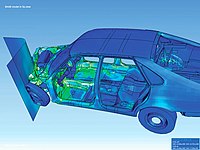
Photo from wikipedia
An original concept of the discrete element method accounting for deformability of cylindrical or spherical particles proposed in [1] will be presented. The deformability of the particles in the new… Click to show full abstract
An original concept of the discrete element method accounting for deformability of cylindrical or spherical particles proposed in [1] will be presented. The deformability of the particles in the new method, called the deformable discrete element method (DDEM) is taken into account in a simplified way which does not increase the computational cost of the DEM too much. It is assumed that the particle deformation is composed of the global and local deformation modes. The global deformation mode is evaluated assuming a uniform strain in the particle induced by the volume-averaged stress derived in terms of the contact forces acting on the particle. The particle strains are obtained via the inverse constitutive relationship from the averaged particle stress. The linear elastic material model is assumed for the particle global deformation mode. The deformed shape (global deformation) of the particle is obtained by an integration of the particle strain. The local deformation modes are assumed at contact zones, and they are represented by the overlaps of the globally deformed particles. The normal contact forces are determined as functions of the overlaps.
Journal Title: International Journal for Numerical Methods in Engineering
Year Published: 2018
Link to full text (if available)
Share on Social Media: Sign Up to like & get
recommendations!